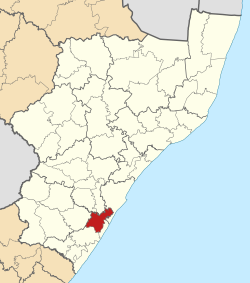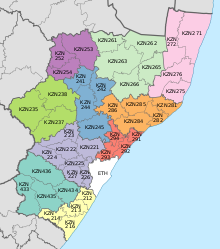| Revision as of 10:43, 21 January 2021 editMonkbot (talk | contribs)Bots3,695,952 editsm Task 18 (cosmetic): eval 5 templates: hyphenate params (7×);Tag: AWB← Previous edit | Revision as of 01:25, 21 July 2021 edit undoSadads (talk | contribs)Administrators147,245 editsm link timber plantation using Find linkNext edit → | ||
| Line 90: | Line 90: | ||
| The Vulamehlo Municipality was largely made up of traditional settlements and was characterised by limited economic activity. The area has high levels of unemployment, with many of those who are employed commuting long distances to other economic centres such as ], ], ], ] and ]. | The Vulamehlo Municipality was largely made up of traditional settlements and was characterised by limited economic activity. The area has high levels of unemployment, with many of those who are employed commuting long distances to other economic centres such as ], ], ], ] and ]. | ||
| The main sources of income and economic activities in the municipality include subsistence farming and commercial agriculture, including the production of ] and timber plantation. Small-scale sugarcane growers tend to cluster around ], Kenterton and Mfume. | The main sources of income and economic activities in the municipality include subsistence farming and commercial agriculture, including the production of ] and ]. Small-scale sugarcane growers tend to cluster around ], Kenterton and Mfume. | ||
| The dispersed, low-density settlement pattern has made the provision of physical and social infrastructure (roads, water, electricity, clinics, schools, and police stations) relatively difficult and expensive. The network of roads connecting the area's settlements is generally poor. The area of former Vulamehlo Municipality is one of the localities within the Ugu District that is hardest hit by high unemployment levels, poverty, and negative economic growth rate.<ref> {{Webarchive|url=https://web.archive.org/web/20090821182618/http://kzntopbusiness.co.za/site/vulamehlo |date=2009-08-21 }} KwaZulu-Natal Top Business. Retrieved on Oct 7, 2009.</ref> | The dispersed, low-density settlement pattern has made the provision of physical and social infrastructure (roads, water, electricity, clinics, schools, and police stations) relatively difficult and expensive. The network of roads connecting the area's settlements is generally poor. The area of former Vulamehlo Municipality is one of the localities within the Ugu District that is hardest hit by high unemployment levels, poverty, and negative economic growth rate.<ref> {{Webarchive|url=https://web.archive.org/web/20090821182618/http://kzntopbusiness.co.za/site/vulamehlo |date=2009-08-21 }} KwaZulu-Natal Top Business. Retrieved on Oct 7, 2009.</ref> | ||
Revision as of 01:25, 21 July 2021
Local municipality in KwaZulu-Natal, South Africa| Vulamehlo | |
|---|---|
| Local municipality | |
 Seal Seal | |
 Location of Vulamehlo Local Municipality within KwaZulu-Natal Location of Vulamehlo Local Municipality within KwaZulu-Natal | |
| Coordinates: 30°13′S 30°36′E / 30.217°S 30.600°E / -30.217; 30.600 | |
| Country | South Africa |
| Province | KwaZulu-Natal |
| District | Ugu |
| Seat | Scottburgh |
| Wards | 10 |
| Government | |
| • Type | Municipal council |
| • Mayor | W.T. Dube |
| Area | |
| • Total | 960 km (370 sq mi) |
| Population | |
| • Total | 77,403 |
| • Density | 81/km (210/sq mi) |
| Racial makeup (2011) | |
| • Black African | 98.9% |
| • Coloured | 0.2% |
| • Indian/Asian | 0.5% |
| • White | 0.3% |
| First languages (2011) | |
| • Zulu | 94.6% |
| • English | 1.7% |
| • Southern Ndebele | 1.3% |
| • Other | 2.4% |
| Time zone | UTC+2 (SAST) |
| Municipal code | KZN211 |
Vulamehlo Local Municipality was a local municipality in Ugu District Municipality, KwaZulu-Natal. It was located south of the eThekwini municipality and bordered by uMdoni to the east, Mkhambathini and Richmond to the north and Ubuhlebezwe to the west. There is an almost equal split of land between commercial agriculture and traditional settlement areas. 48% of the area is held under communal ownership through traditional authorities; the balance of the area is privately owned, except for Vernon Crookes Nature Reserve, which is managed by Ezemvelo KZN Wildlife. In 2016 the municipality was divided between eThekwini and uMdoni.
Topography
The municipality was characterised by sharp valleys, river systems, and hilly, broken terrain. Approximately 30% of the area was estimated to contain slopes of 1:3 and steeper. The fragmented and steep topography had limited development and agricultural production, and had greatly contributed to the dispersed nature of the area's settlement patterns.
The major river systems within the area were the uMkhomazi, Mpambanyoni and Mthwalume rivers. The other perennial rivers which flow through Vulamehlo included the Nungwane River, Lovu River, Msimbazi River, Mzimayi River, uMzinto and Mkhumbane rivers.
Economy and infrastructure
The Vulamehlo Municipality was largely made up of traditional settlements and was characterised by limited economic activity. The area has high levels of unemployment, with many of those who are employed commuting long distances to other economic centres such as Durban, Port Shepstone, Ixopo, Pietermaritzburg and Johannesburg.
The main sources of income and economic activities in the municipality include subsistence farming and commercial agriculture, including the production of sugarcane and timber plantation. Small-scale sugarcane growers tend to cluster around Dududu, Kenterton and Mfume.
The dispersed, low-density settlement pattern has made the provision of physical and social infrastructure (roads, water, electricity, clinics, schools, and police stations) relatively difficult and expensive. The network of roads connecting the area's settlements is generally poor. The area of former Vulamehlo Municipality is one of the localities within the Ugu District that is hardest hit by high unemployment levels, poverty, and negative economic growth rate.
Main places
The 2001 census divided the municipality into the following main places:
| Place | Code | Area (km) | Population |
|---|---|---|---|
| Cele | 50101 | 22.43 | 4,682 |
| Emandleni | 50102 | 60.83 | 10,606 |
| Ezembeni | 50103 | 86.46 | 13,462 |
| Isimahla | 50104 | 66.40 | 5,291 |
| Izimpethu Endlovu | 50105 | 14.78 | 1,104 |
| Izimpethu Zendlovu & EM | 50106 | 15.97 | 5,619 |
| Mapumulo | 50107 | 44.86 | 6,200 |
| Mbhele | 50108 | 49.52 | 3,725 |
| Nyuswa | 50109 | 16.96 | 1,892 |
| Qiko | 50110 | 49.16 | 3,074 |
| Thoyana | 50111 | 104.87 | 14,637 |
| Ukuthula | 50112 | 8.11 | 2,090 |
| Umzinto | 50113 | 36.06 | 6,397 |
| Remainder of the municipality | 50114 | 395.50 | 4,272 |
Politics
The municipal council consisted of twenty members elected by mixed-member proportional representation. Ten councillors were elected by first-past-the-post voting in ten wards, while the remaining ten were chosen from party lists so that the total number of party representatives was proportional to the number of votes received. In the election of 18 May 2011 the African National Congress (ANC) won a majority of thirteen seats on the council. The following table shows the results of the election.
style="width: 2px; color:inherit; background-color: #006600;" data-sort-value="African National Congress" | style="width: 2px; color:inherit; background-color: #FF8040;" data-sort-value="National Freedom Party" | style="width: 2px; color:inherit; background-color: #FF0000;" data-sort-value="Inkatha Freedom Party" | style="width: 2px; color:inherit; background-color: #ba0c2f;" data-sort-value="African Christian Democratic Party" || Party | Votes | Seats | ||||||
|---|---|---|---|---|---|---|---|---|
| Ward | List | Total | % | Ward | List | Total | ||
| ANC | 15,281 | 15,614 | 30,895 | 63.6 | 9 | 4 | 13 | |
| NFP | 6,325 | 6,039 | 12,364 | 25.4 | 1 | 4 | 5 | |
| IFP | 2,488 | 2,463 | 4,951 | 10.2 | 0 | 2 | 2 | |
| ACDP | 195 | 202 | 397 | 0.8 | 0 | 0 | 0 | |
| Total | 24,289 | 24,318 | 48,607 | 100.0 | 10 | 10 | 20 | |
| Spoilt votes | 510 | 515 | 1,025 | |||||
References
- "Contact list: Executive Mayors". Government Communication & Information System. Archived from the original on 14 July 2010. Retrieved 22 February 2012.
- ^ "Statistics by place". Statistics South Africa. Retrieved 27 September 2015.
- "Statistics by place". Statistics South Africa. Retrieved 27 September 2015.
- ^ Vulamehlo Integrated Development Plan (2009/2010 Final Review). Vulamehlo Municipality. Retrieved on Oct 7, 2009.
- "Vulamehlo Municipality." Archived 2009-08-21 at the Wayback Machine KwaZulu-Natal Top Business. Retrieved on Oct 7, 2009.
- Lookup Tables - Statistics South Africa
- "Results Summary – All Ballots: Vulamehlo" (PDF). Independent Electoral Commission. Retrieved 3 December 2013.
- "Seat Calculation Detail: Vulamehlo" (PDF). Independent Electoral Commission. Retrieved 3 December 2013.
